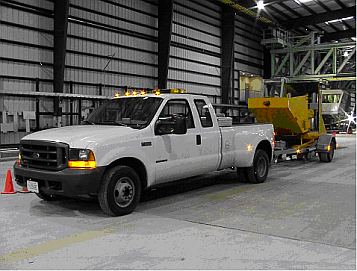CC2 Phase IV NDT Procedure and Data
HWD testing was conducted to assess pavement uniformity, pavement modulus, and deterioration in the pavement structure. FWD testing was conducted to quantify slab deterioration, measure load transfer efficiency along joints, and verify cracks detected by strain sensors before they reach the pavement surface. NDT Test Results HWD and FWD tests were conducted prior to testing and at various intervals after the start of testing. These tests were useful in determining at what coverage level the pavement experienced significant loss of bearing capacity. Data from the HWD and FWD testing can be found below.
Falling Weight Deflectometer Testing
FWD tests were conducted to test the following:
- Slab deterioration under traffic;
- Measure the variation of the joint load transfer capabilities during the traffic test;
- Verify the cracks detected by strain sensors but before they are observed from slab surface
Different FWD testing procedures were followed for each testing purpose. The following subsections give detailed information for each specific FWD test.
Slab Deterioration Test
Location: Center of each slab in the two in-lanes in MRG and MRS, ten drops for MRG and MRS, twenty drops in total.
Time: After every 15 wanders of traffic are completed for MRG and MRS. The tests will be done at end of 15, 30, 45, 60, wanders until special notice to change the testing frequency. (If the data received from two consequent tests are almost the same, next test could be done after additional 30 wanders. However, whenever the received data show significant change in D0 comparing to the previous ones, next FWD test should be done after 15 wanders)
Plate Size: 12 inch
Procedures: Three drops, 12,000, 24,000 and 36,000 lbs at each location plus a seating drop with load 36,000 lbs
Joint Load Transfer Variation Tests
Location: At four inside transverse joints, in-lane slabs only (the two end-joints. Do not need tests). Loads need to be dropped on two sides of each joint and tangential to the joint. The spacing between the FWD loading plate edge and the joint center line should be smaller than one inch. Eight drops are on each side of MRG and MRS, 32 drops are in total.
Time, Plate size and procedure: The same to Slab Deterioration Tests
Verification of Bottom Crack Tests
Location & Time: It is expected that both MRG and MRS will have cracks initialized from slab bottom, and near the center of longitudinal joint but not observed from the slab surface. When a crack has been observed by strain gages, the FWD tests will be done and the loading location will be determined based on the data received from the strain gages. Number of locations will be limited no more than five in total.
Procedure: The same to slab deterioration tests. Loads need to be dropped on two sides of the longitudinal joint.
Heavy Weight Deflectometer Testing
Heavy Weight Deflectometer Details
The FAA’s HWD, Kuab Model 240 shown in Figure 2, has been extensively described in [2]. During the CC2 HWD testing, the FAA standard configuration was used: 12-inch (30.5-cm ) diameter plate, pulse width of 27-30 msec, and four drop heights: 36-kips ( 160-kN ) seating drop followed by impact loads of 12-kips ( 53-kN ), 24-kips ( 106-kN ), and 36-kips ( 160 kN ). HWD deflections were measured at the center of the load plate ( D0 ), at 12-inch ( 30-cm ) offset ( D2 ), 24-inch ( 60-cm ) offset ( D3 ), 36-inch ( 90-cm ) offset ( D4 ), 48-inch ( 120-cm ) offset ( D5 ), 60-inch ( 150-cm ) offset ( D6 ) and 72-inch ( 180-cm ) offset ( D7 ). An additional sensor was placed at 12-in ( 30-cm ) offset ( D1 ) on the front of the loading plate.
Heavy Weight Deflectometer Test Procedure
HWD testing was conducted March 5 to December 17, 2004. HWD tests were performed on the slab centers and on both sides of the outboard longitudinal joints opposite the slab centers (Figure 1). The tests were performed prior to trafficking, periodically during trafficking, and at the end of trafficking. Tests were performed twice during trafficking of the MRC test item. During a longer traffic period, the MRG and MRS test items were subjected to HWD runs at intervals of 15 test vehicle wanders up to 5,000 passes, 30 wanders up to 7,000 passes, and 60 wanders for the remainder of the testing which exceeded 30,000 passes. HWD tests had also been run on the exposed Econocrete, P-306, after demolition of the CC-1 slabs and prior to placement of the CC-2 slabs on February 9, 2004. The data were used for back-calculation of the layer properties without the influence of the upper concrete pavement layer.

Figure 1. Heavy Weight Deflectometer
Back to CC2 Phase IV Test Items